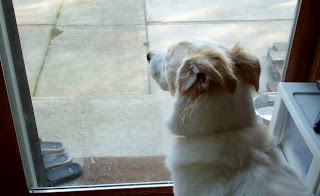“Could you come here for a second?”
“In a minute …”
“I need you to come now.”
“At the commercial.”
“Could you come here, please?”
“Sure, just after I finish this ….”
As humans, we learn quickly that when someone calls for us, it usually means that they want us to do something for him/her, and usually it’s something we don’t care to do. We don’t want to come, but we might feel obliged to do so depending on the urgency of tone or who’s doing the calling. But what if we knew that every time we were called, it was to do or receive something we enjoyed more than anything else? Most of us came running when grandma called.
A strong recall is one of the most desired behaviors for dog owners but it’s also one of the most difficult ones to achieve reliably. It’s not complicated to train. Dogs react the same way we do. A good recall of humans and dogs relies on one key principle: the one being called must want to come.
There are three rules to build a good recall. First, only recall for something good, a treat, a walk, a game of ball, or anything else that’s enjoyable. Second, only recall when one hundred percent sure the recall will work. And lastly, only use the command (and it must be a command, not just a name) once.
Rewarding a recall builds anticipation and enthusiasm. It’s the one time when “no reward” is not an option. Use a variety of high value rewards associated when training recall – chicken, the best game of tug ever, a car ride, the arrival of a cherished friend to build excitement about coming. And never call for anything “bad” – a bath, trip to the vet, nail clipping, etc. It can’t be emphasized enough that coming when called, no matter how slow, must ALWAYS be rewarded and preferably with a smile. Many frustrated dog owners call their dog after it has run away and when the dog arrives too slowly or reluctantly (possibly due to tone), the dog is scolded or worse, which prompts progressively slower and more reluctant responses the next time it is called until it doesn’t respond at all, or even runs away in terror. The dog associates their owner’s response with the dog’s last action. Always welcome the prodigal dog’s return. Which leads to Rule #2: Only call when you’re sure the dog will come.
 |
| Practice recall in a low distraction area first |
Don’t call the dog if it is distracted or hyper-focused on something more interesting than you. The brain can only respond to one stimulus at a time. Avoid a frustrating situation and go get the dog. It’s not that dogs can’t come under highly distracting conditions, but it must be trained. Start by practicing recall in low distraction areas with minimal distance, only a couple of feet at first. Gradually build distance and distraction (never both simultaneously). Time and experience will teach the dog that coming when called pays off better than chasing after a squirrel. In the meantime, if the suspicion is that the temptation is more valuable than you, go and get the dog or better yet, capture the dog’s attention before it becomes “locked and loaded” and reward heavily for the attention.
Finally, don’t make yourself upset by giving a recall command multiple times. If you sincerely believe the dog was out of hearing range, then call again. Otherwise, the word loses its value and anger builds. Calling multiple times becomes nagging or background noise. We all remember mom saying, “How many times have I told you …” but few of us remember exactly how many times she did tell us and at that point we don’t care. By limiting the recall to one command, we can keep our tempers in check while we go to the dog. When we’re close enough to regain its attention, we can still feel comfortable rewarding the dog when it does finally come.
Training a good recall is convenient and vital for safety. While it takes time and practice, it’s well worth the investment. When you’re out on the trail and your dog responds enthusiastically to your recall, there’s that thrill to it. As dog owners, there’s a sense of accomplishment when our dogs have decided we’re the best thing in their world. Even better than squirrels.



